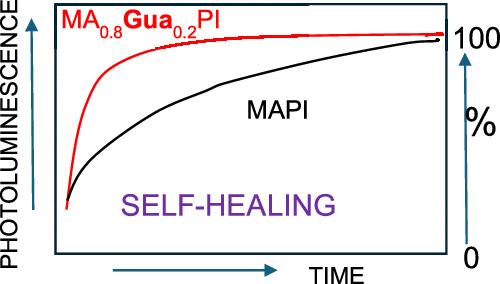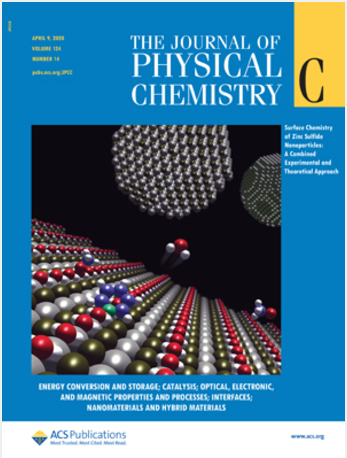胍基取代可提高 MAPbI3 的自愈性和抗光损伤能力
IF 3.3
3区 化学
Q2 CHEMISTRY, PHYSICAL
引用次数: 0
摘要
自愈合材料可以改变可持续(光)电子器件的发展方向。APbX3 卤化物(=X-)包晶石(HaPs)已显示出卓越的损伤自愈能力。虽然我们在纯 HaP 化合物、单晶和多晶薄膜(用于大多数设备)中展示了自愈能力,但对于太阳能电池来说,含有多种 A+(和 X-)成分的 HaP 组合物是首选。现在,我们展示了混合 A+ HaPs 的自愈能力。具体来说,如果用胍(Gua+)或乙酰脒(AA+)取代至少 15 原子%的甲基铵(MA+)A 阳离子,则会提高损坏后的自愈率。相反,用二甲基铵(DMA+)代替 MA+(其大小与 Gua+ 或 AA+相当)不会改变这一速率。根据自愈合的时间,我们推断决定速率的步骤涉及 A+ 和/或 Pb2+ 阳离子的短程扩散,自愈合速率与材料中的应变、A+ 阳离子偶极矩以及 A+ 和 I- 之间的 H 键相关。这些见解可能为制定详细的自愈合机制和了解动力学提供线索,从而指导自愈合材料的设计。从器件的角度来看,快速恢复动力学非常重要,因为它能使器件在运行期间或关闭(发光二极管)/黑暗中(光伏)时完全恢复。本文章由计算机程序翻译,如有差异,请以英文原文为准。

Guanidinium Substitution Improves Self-Healing and Photodamage Resilience of MAPbI3
Self-healing materials can become game changers for developing sustainable (opto)electronics. APbX3 halide (=X–) perovskites, HaPs, have shown a remarkable ability to self-heal damage. While we demonstrated self-healing in pure HaP compounds, in single crystals, and in polycrystalline thin films (as used in most devices), HaP compositions with multiple A+ (and X–) constituents are preferred for solar cells. We now show self-healing in mixed A+ HaPs. Specifically, if at least 15 atom % of the methylammonium (MA+) A cation is substituted for by guanidinium (Gua+) or acetamidinium (AA+), then the self-healing rate after damage is enhanced. In contrast, replacing MA+ with dimethylammonium (DMA+), comparable in size to Gua+ or AA+, does not alter this rate. Based on the times for self-healing, we infer that the rate-determining step involves short-range diffusion of A+ and/or Pb2+ cations and that the self-healing rate correlates with the strain in the material, the A+ cation dipole moment, and H-bonding between A+ and I–. These insights may offer clues for developing a detailed self-healing mechanism and understanding the kinetics to guide the design of self-healing materials. Fast recovery kinetics are important from the device perspective, as they allow complete recovery in devices during operation or when switched off (LEDs)/in the dark (photovoltaics).
求助全文
通过发布文献求助,成功后即可免费获取论文全文。
去求助
来源期刊

The Journal of Physical Chemistry C
化学-材料科学:综合
CiteScore
6.50
自引率
8.10%
发文量
2047
审稿时长
1.8 months
期刊介绍:
The Journal of Physical Chemistry A/B/C is devoted to reporting new and original experimental and theoretical basic research of interest to physical chemists, biophysical chemists, and chemical physicists.
 求助内容:
求助内容: 应助结果提醒方式:
应助结果提醒方式:


